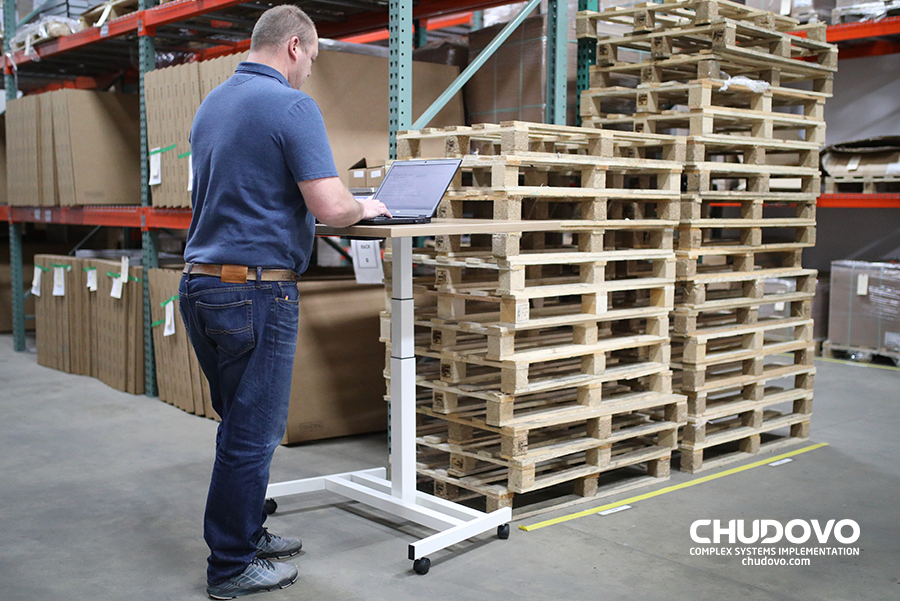
Efficiency and Accuracy: The Advantages of Implementing Warehouse Management Systems
In recent years, warehouse management systems (WMS) have become increasingly popular due to their ability to manage and optimize warehouse operations. They provide real-time information about inventory levels, location, and movement of goods, as well as order processing and delivery. By streamlining processes and improving accuracy, WMS can improve customer satisfaction and reduce costs. In this paper, we’ll look at the benefits of implementing a WMS, including improved inventory accuracy, improved performance, and optimized space and workforce usage. We will also discuss the key features of WMS and provide examples of leading vendors and solutions.
Table of contents
- What Is Warehouse Management System?
- Pros Warehouse Management System
- Cons Warehouse Management System
- Pros and Cons WMS in the Table
- Warehouse Management System Features
- Examples of Warehouse Management System
- Conclusion
- FAQ

What Is Warehouse Management System?
A Warehouse Management System is software used to manage and optimize warehouse operations. It is designed to provide real-time information about inventory levels, location, movement of goods, order processing, and delivery. According to a ReportLinker report, the global Warehouse Management Systems (WMS) market was valued at $2.4 billion in 2020 and is expected to reach $5.1 billion by 2025 at a CAGR of 16.0% from 2020 to 2025. The report cites factors such as the growth of e-commerce and the need for real-time supply chain surveillance as driving the market growth.
WMS typically includes several features that help warehouse managers efficiently organize and manage warehouse operations. For example, it could be
- Inventory tracking—managers can monitor the availability of products and make sure they are in the right place.
- Order management – managers can track incoming orders and process them from receipt to dispatch.
- Automatic data collection helps reduce errors and improve inventory accuracy.
Another key benefit of using warehouse management solutions is that it maximizes team productivity. This helps managers streamline warehouse operations, reduce the time it takes to find and retrieve products and minimize human errors. Thus, WMS allows managers to optimize warehouse processes. This may include tracking warehouse, orders, and shipping.
Pros Warehouse Management System
You need to start your acquaintance with warehouse management systems software with the pros because they are the majority in this area. If we briefly summarize what will be discussed further, it is about reducing costs and increasing productivity. You can read more about all the benefits below.
Inventory tracking and real-time visibility
With this information, warehouse managers can more effectively track inventory levels, identify potential stockouts, and make more informed inventory management decisions. Moreover, WMS can reduce the need for manual labor, which in turn will minimize the risk of human error. This will also have a positive effect on increasing customer satisfaction. A management system can provide valuable information about the productivity of employees in a warehouse. This will allow managers to identify areas for improvement and streamline operations, which will improve efficiency.
Improved order processing and shipping
Using WMS, managers can streamline the entire process from order receipt to shipment, ensuring each step is completed accurately and quickly. This allows you to control the process and, if a problem is found, quickly solve it. In addition, WMS allows managers to track inventory levels and follow the supply chain of goods to the warehouse in real-time. This can help identify areas for improvement and prevent shortages. It will also be possible to understand which product is too much and rebuild the marketing strategy.
Increase productivity and efficiency
By automating inventory management, order picking, and shipping, you can greatly increase employee productivity. Work optimization allows employees to devote more time to coordinating work, rather than directly performing it. You can also track statistics that will give an understanding of the goods and what is in demand, this will allow you to more rationally allocate the budget.
Price drop
By reducing the likelihood of overstocking and stockouts, WMS can help managers reduce inventory management costs. WMS also allows you to replace some employees, for example, the same warehouse operators. The whole system has one base and therefore some employees are no longer needed. This in turn also reduces the cost of the work itself. In addition, WMS can help managers optimize warehouse operations by identifying areas of inefficiency and suggesting improvements. With all these benefits, it’s no surprise that many businesses are turning to WMS to improve their inventory management processes.
Increasing customer satisfaction
Based on all the points discussed above, WMS can make customers more satisfied. This will manifest itself in the fact that customers will be able to receive clearer information about the product, for example, they will be able to track the delivery. This is to add transparency to the WMS process, which will increase the overall trust of the client.

Cons Warehouse Management System
Warehouse management systems offers many benefits, but there are also some potential drawbacks to consider. These shortcomings are only at the beginning of use, so they do not drastically affect the overall operation of the system. That is why it is important to understand that one-time problems are not something that you should not try with WMS features. These include:
High price
One of the main disadvantages of implementing WMS is the cost. Depending on the size and complexity of the warehouse, implementing a WMS can be quite expensive. This may include costs associated with software licenses, hardware upgrades, and staff training.
Complexity
Another potential disadvantage of WMS is the complexity of the system. Depending on the software vendor and the level of customization required, implementing a WMS can be a complex process that requires careful planning and testing. This can be a major problem for businesses that lack the necessary knowledge or resources to manage the implementation process. Also, employee training can take a long time.
Limited customization
Finally, some providers of WMS may offer limited customization options. This can be an issue for businesses that require custom warehouse management solutions. In addition, the system may not be able to adapt to changing business needs over time, which may limit its usefulness in the long run.
Pros and Cons WMS in the Table
For clarity, it is important to make a table in which it is clear that there are much more advantages. The fact is that an automated system not only simplifies the work of the team but also speeds up the process of scaling the business. For example, the system will contain data on the warehouse layout, the availability of goods, and customer orders, and such a single database will be much easier to integrate new employees. And depending on the pace of development of IT technologies, more and more functions will appear that can be integrated. All the shortcomings boil down to the fact that there may be problems at the first stages of business implementation. This is true because you will need to spend money on the system and equipment for it. It can also be difficult to teach employees how to use it. But this is the price of progress, and you need to understand that e-commerce and other industries are developing, and you need to meet the current level of customer needs.
| Pros | Cons |
| Inventory tracking and real-time visibility | High price |
| Improved order processing and shipping | Complexity |
| Increase productivity and efficiency | Limited customization |
| Price drop | |
| Increasing customer satisfaction |
Warehouse Management System Features
Warehouse management systems (WMS) include a plethora of features that assist warehouse managers in efficiently organizing and managing warehouse operations. Each supplier has different functions of warehouse management system, only the most popular ones that can be found here will be listed. Some key features of WMS include:
Inventory management
Enterprise warehouse management is a core function of WMS, but it goes beyond ensuring that inventory is in the right place. It also helps managers track the movement of goods in and out of the warehouse, keep track of product availability and ensure that they are properly stored. This feature also allows managers to identify potential shortages and make informed product management decisions. In addition, it can help managers optimize operations by identifying slow-moving items and reducing excess inventory. This allows us to respond more quickly to turnover and customer demand.
Order management
The function of WMS order management is not only about the smooth processing of orders, from receipt to dispatch. It provides real-time visibility into orders, allowing managers to prioritize shipping, allocate inventory, and streamline the picking and shipping process. In addition, it can help warehouse manager improve customer service by providing accurate and timely information about order status, delivery dates, and more. This will increase trust and customers will return to your store again.
Automated data collection
Automated data collection is a key feature of WMS. This helps reduce errors and improve inventory accuracy by automating data collection tasks. This feature also allows managers to monitor inventory availability and movement in real-time, ensuring inventory is always up-to-date. Thanks to statistics, it will be possible to get information about more popular products and understand what is in demand. In addition, it can help managers improve the efficiency of their processes by reducing the time spent on manual data entry and processing.
Labor management
Labor management is another important WMS function. It helps managers optimize space and workforce utilization by providing real-time performance and workforce performance data. This feature also allows managers to track employee performance and identify areas for improvement. Thus, it can help managers improve the safety of their warehouse, reduce employee costs, and increase productivity.
Reporting and analytics
WMS can provide real-time data and analytics. This allows managers to make informed decisions and respond quickly to changes in demand or disruptions in the supply chain. The feature includes informational reports that provide real-time insight into warehouse performance, inventory levels, and order processing. Using the data collected by the system, managers can obtain data that can help identify opportunities for improvement.
Mobile access
Many WMS providers offer access to their systems through mobile applications. This allows managers to access data from anywhere and at any time. This feature allows managers to stay connected and make informed decisions on the go. It also allows managers to monitor their operations remotely, reducing the need for field trips and improving their ability to quickly respond to issues.
Integration with other systems
Features WMS can also be integrated with other systems such as enterprise resource planning (ERP) systems, transportation management systems (TMS), or other third-party software. This allows managers to streamline their operations and streamline supply chain processes. By integrating with other systems, managers can reduce the time spent on manual data entry and improve data accuracy.
Barcode scanning
Barcode scanning is a handy feature in warehouse management systems. It helps managers automate data collection tasks, reduce errors, and improve inventory accuracy. This feature allows managers to track the movement of goods, monitor inventory levels and ensure that products are in the right place. By using barcode scanning, managers can increase the efficiency of their processes and reduce the risk of errors.
Voice-directed picking
Voice Guidance is a feature that allows warehouse workers to receive instructions and recommendations through a voice-activated device. This feature helps improve accuracy and productivity by reducing the need for manual data entry and paperwork. By providing workers with clear and concise instructions, managers can reduce the risk of errors and increase the efficiency of their processes. But it is also worth understanding that voice input may not work correctly, and you should double-check what was entered.
RFID integration
Some WMS providers offer integration with Radio Frequency Identification (RFID) technology. This is a technology used to track and identify objects using radio waves. RFID systems typically consist of an RFID tag, which contains a unique identifier, and an RFID reader, which uses radio waves to communicate with the tag and read its identifier. RFID technology is often used in warehouse management systems to track inventory movement and control stock levels in real-time using RFID tags and readers. Using this technology, managers can improve the accuracy of their inventory data and reduce the time spent on manual data entry and processing. In addition, RFID integration can help managers increase the security of their warehouse by providing real-time alerts when goods are moved without permission.

Examples of Warehouse Management System
By streamlining processes and improving accuracy, WMS can improve customer satisfaction and reduce costs. One important aspect of WMS implementation is choosing the right provider. There are many options available, each with its features, functions, and price. To help you get started, we’ve compiled a list of some top WMS providers:
SAP Extended Warehouse Management
SAP EWM is a solution for managing high-volume warehouse operations. It offers features such as cross-docking, wave picking, and yard management, as well as integration with other SAP systems.
Oracle Warehouse Management Cloud
Oracle WMS Cloud is a cloud-based solution that provides real-time inventory tracking and visibility, as well as order processing and shipping. It includes features such as cycle counting, wave picking, and task interleaving.
JDA Warehouse Management
JDA WMS is a solution designed for complex warehouse operations. It includes features such as wave picking, cross-docking, and slotting optimization, as well as integration with other JDA systems.
Manhattan SCALE
It is the solution for managing warehouse operations in distribution centers and fulfillment centers. It includes features such as task interleaving, and labor management, as well as integration with other Manhattan systems.
Infor Warehouse Management
Infor WMS is a solution for managing warehouse operations in manufacturing, distribution, and retail environments. It includes features such as wave picking, cross-docking, and task interleaving, as well as integration with other Infor systems.
HighJump Warehouse Management Solution
HighJump WMS is a solution for managing warehouse operations in distribution and manufacturing environments. There are some features such as wave picking, task interleaving, and labor management, as well as integration with other HighJump systems.
Tecsys EliteSeries WMS
Tecsys EliteSeries WMS is a solution for managing warehouse operations in healthcare, retail, and distribution environments. It includes features such as wave picking, task interleaving, and slotting optimization, as well as integration with other Tecsys systems.
Softeon Warehouse Management System
Softeon WMS is a solution for managing warehouse operations in retail, e-commerce, and distribution environments. It includes some features, for example, wave picking, cross-docking, and task interleaving, as well as integration with other Softeon systems.
Körber Supply Chain Execution
Körber SCE is a suite of supply chain execution solutions that includes a WMS, as well as solutions for transportation management, labor management, and more. The WMS includes features such as wave picking, task interleaving, and labor management, as well as integration with other Körber systems.
Zebra Technologies FulfillmentEdge
Zebra FulfillmentEdge is a cloud-based solution for managing warehouse operations in e-commerce and retail environments. It includes features such as wave picking, task interleaving, and labor management, as well as integration with other Zebra systems.

Certified engineers
Convenient rates
Fast start
Profitable conditions
Agreement with
EU company
English and German
speaking engineers
As you can see, most firms have the same warehouse management system functionality. Most often it is cross-docking, wave picking, and warehouse management, as well as integration with other company systems. That is why, before choosing which company you will agree with, you need to determine what is closer to you and what conditions of cooperation are more suitable for you. The management interface can be cast on this, you need to test each one and then select the one that will be the most convenient.
Conclusion
Summing up, we can say that WMS is an excellent solution for those companies that want to develop and be relevant in the market. Many companies are ready to provide their services to companies. These services may differ, but the underlying essence of process optimization remains. Some difficulties may arise during the implementation of the system, but in the future, all members of the company will notice how much easier it has become to perform basic actions. WMS allows you to speed up repetitive processes, which in turn will lead to increased work efficiency. Employees will spend more time analyzing profitability, and not on routine matters.
FAQ
In this section, you can find out about the most asked questions and get answers to them. This section will help you summarize the information and get rid of doubts about using WMS.
What are the benefits of using a WMS?
Using a WMS can improve inventory accuracy, increase productivity, improve customer satisfaction, and optimize the use of space and labor. By providing real-time data on inventory levels and locations, a WMS helps managers to better organize and manage warehouse operations, leading to reduced costs and improved customer satisfaction.
How does a WMS improve inventory accuracy?
WMS allows managers to monitor inventory levels and locations in real-time, helping to reduce errors and increase accounting accuracy. By providing automatic data collection functionality, WMS also helps reduce errors and increase order fulfillment speed.
How does a WMS increase productivity?
A WMS helps to streamline warehouse operations, reduce the time needed to locate and retrieve products and minimize errors. This improves productivity and enables managers to optimize the use of space and labor.
How does a WMS improve customer satisfaction?
With faster order processing and shipping, a WMS helps to improve customer satisfaction. By providing real-time data on inventory levels and locations, a WMS also helps to ensure that products are available and can be shipped quickly.
Contact us now and start digital integration for your logistics and supply chain business!

